Top 7 Tips To Make Real Money With Amazon Associates
I have been an Amazon affiliate (their affiliate program is called Amazon Associates) for many years. However, all I do with it is the occasional affiliate link on a book I am talking about, and as a consequence I make $20 or $30 monthly with the program.Given that the commissions are quite low, I figured this is normal for most people. Then a couple of weeks ago I came across a post from Chris Gurthie titled “Top 7 tips I used to make $41,438.42 in 2009 with Amazon Associates“. It caught my attention for obvious reasons. Here is a quote from the article:
3. Focus on in content affiliate linking: 45% of total earningsThe interesting thing is that Chris breaks down exactly where his affiliate commissions are coming from. For instance, 45% of his earnings came from in content affiliate links, while 15% came from best-selling lists.
The biggest chunk of money I earned was by linking to products inside the actual blog posts I was writing about. Say for example I was discussing a new product that was now available to pre-order. First I would link to it because it was available for pre-order with no mention of the price. Then I’d show an image and use an affiliate link for that (more on images in the later tips). Then after the image I’d share a few of the products specs but then use an affiliate link titled something like “see full specs” and then if there were other colors I’d link to each one of those individually.
It is worth a read if you are considering to earn money promoting Amazon products (or if you are already doing so, but with mediocre results).
11 Lessons I Learned Earning $119,725.45 from Amazon Associates Program
I have earned $119,725.45 from Amazon Associates Program since I began using it as a way to make money online late in 2003. Around half of that amount was made within the last 12 months.In this post I want to share what I’ve learned along the way on how to make money with Amazon.
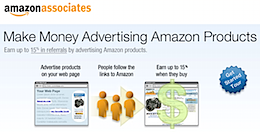 While Amazon’s Associates program is not my largest income stream (I rank how I make money blogging here) it was actually the first experiment that I did with monetizing blogs. I began to experiment with it in the last quarter of 2003 (just before I started using AdSense).
While Amazon’s Associates program is not my largest income stream (I rank how I make money blogging here) it was actually the first experiment that I did with monetizing blogs. I began to experiment with it in the last quarter of 2003 (just before I started using AdSense). I started using it on a personal blog that had been going for around 12 months and had around a thousand readers a day – the first quarter was not spectacular in terms of earnings – I made $31.80 (around 30 cents a day) and almost gave it away.
I’m glad I stuck with it – here’s a chart of the quarterly earnings since the last quarter of 2003 (note, it doesn’t include July or August of this year as that’s an incomplete quarter so the overall figures from this period is below the $119k figure mentioned above):
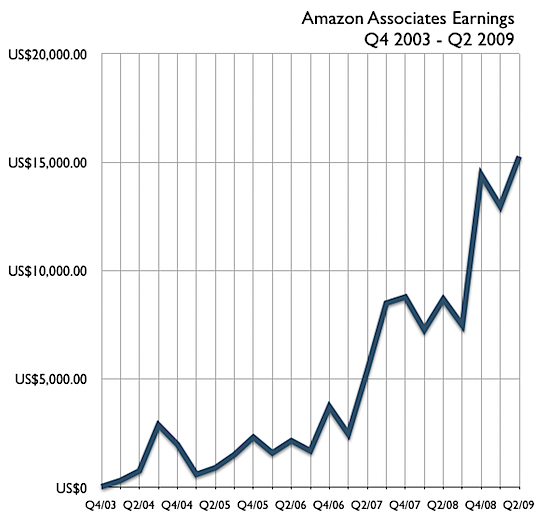
As you can see there has been some ups and downs since the early days but the overall trajectory has been positive. It’s a little hard to see in the chart, as it is quarterly, but Decembers are always great months – last December is still the best month I’ve ever had despite last quarter being a record over a 3 month period.
So what have I learned on the way to earning six figures from Amazon?
Today I want to share 11 tips on what I’ve learned in making money blogging from the Amazon Associates Program. Tomorrow I’ll share another 10 (update: You can read Part 2 here).
1. Traffic Traffic Traffic
 Let’s start with the most obvious point – one of the biggest factors in the upward swing in my Amazon earnings has been a corresponding upward swing traffic.
Let’s start with the most obvious point – one of the biggest factors in the upward swing in my Amazon earnings has been a corresponding upward swing traffic. As with most ways of making money from blogging the more eyeballs that see your affiliate promotions – the better chance you have of it converting (of course this is a generalization as not all kinds of traffic converts – but more of that in the next point).
While I do think it’s worth starting to experiment with affiliate promotions early on in your blog (even before you have a heap of traffic) your main focus in the early days needs to be upon creating great content and building traffic to your blog.
2. Loyalty and Trust Convert
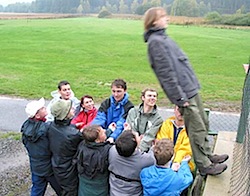 One of the other major factors that has come into play with the increase in earnings that I’ve had has been the type of readership I’ve managed to gather on my blogs. While I do get a fair bit of search engine traffic I’ve found that in most cases (and there is an exception below) search visitors are not converting with affiliate programs on my blogs – instead it is loyal and repeat readers.
One of the other major factors that has come into play with the increase in earnings that I’ve had has been the type of readership I’ve managed to gather on my blogs. While I do get a fair bit of search engine traffic I’ve found that in most cases (and there is an exception below) search visitors are not converting with affiliate programs on my blogs – instead it is loyal and repeat readers.The main reason for this is that those readers who connect with you on a daily basis over the long haul develop a trust with you (and your blog) and so when you make a recommendation or do a review they’re more likely to take that advice.
3. The Intent of Readers Matters
 Another big factor in the equation of Amazon conversions is the intent that your readers have when they visit your blog. Why are they there and at what stage in the ‘buying cycle’ are they at?
Another big factor in the equation of Amazon conversions is the intent that your readers have when they visit your blog. Why are they there and at what stage in the ‘buying cycle’ are they at?I began to think about this just over a year ago as I looked at the growing traffic on my photography site but realized that my Amazon earnings didn’t seem to be keeping up with the traffic growth that I was experiencing. What I realized is that DPS was a blog that was largely writing about ‘tips on how to use a camera’ and that as a result it wasn’t really drawing readers to it who were in a ‘buying mood’. In fact a survey that I did found that many of my readers had recently purchased a camera and were on my site specifically because they wanted to learn how to use it.
As a result I added to the mix of new content on the site more articles relevant to people buying a digital camera. I wrote tips with advice on buying cameras, reviews of digital cameras and equipment etc. This culminated in a while new section on the blog devoted to ‘gear’.
Slowly this has attracted new readers to the blog – readers who are researching their next camera purchase – readers who are more likely to click a link to Amazon and who once there are more likely to make a purchase.
This is where search traffic can convert with affiliate programs – ie when you’re writing content that people in a ‘buying mood’ are searching for.
4. Relevancy Matters
 This is another common sense tip that many of us (yes I failed on this one in my early days) mess up. The more relevant to your audience the products are that you promote the better chance you’ll have of converting.
This is another common sense tip that many of us (yes I failed on this one in my early days) mess up. The more relevant to your audience the products are that you promote the better chance you’ll have of converting.- Promote iPods on your blog that largely talks about spirituality and you are unlikely to convert (believe me, I tried) – promote relevant books, CDs and DVDs instead.
- Promote perfume on your travel blog and you’re unlikely to see many sales – travel books, luggage and other travel products will work better.
 5. Get People in the Door and Let Amazon Do What they’re Good At
5. Get People in the Door and Let Amazon Do What they’re Good At
One of the great things about Amazon is that it is a site people are familiar with, that they trust and that is very good at converting people to be buyers. They have honed their site to present people with relevant products to them (based upon previous surfing and buying habits) and over many years have tweaked their site to convert well. As a result I find that once you get people to visit Amazon (pretty much for any reason) that a percentage of them will naturally end up buying something. The cool thing is that whether they buy the thing you linked to or not – you’ll earn a commission.
While I find specific promotions of particular products work best with Amazon – I also have had some success by getting people in the door for other reasons. For example I recently ran a post on DPS that gave readers a hypothetical $1000 to spend on photography gear and asked them to surf around Amazon and choose what they wanted to buy. The result was 350 comments and quite a few sales.
While a ‘get people in the door’ strategy might seem to grate a little with my ‘Relevancy’ tip in point #4 – the key is to get people in the door in a relevant way. Once they’re there the purchases they make might not be ‘relevant’ to your blog but their motivation to visit should be.
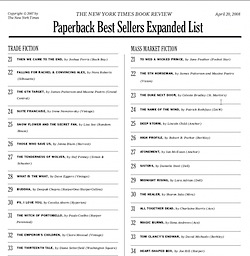 6. Social Proof Marketing 1 – Best Seller Lists
6. Social Proof Marketing 1 – Best Seller Lists
People are more willing to make a purchase if they feel that they’re not alone and if they know that others have and are buying with them. I’m sure there’s some insightful psychological reasons for this but from where I sit buying seems to somehow have become a communal activity.One of the most powerful social proof marketing strategies that I’ve used with promoting Amazon affiliate links is creating ‘Best Seller’ type lists for readers to show them what is currently popular in terms of purchases in our community.
The best example that I can give of this technique in action is my Popular Digital Cameras and Gear page on DPS. It’s a page that I update every three months, that I link to prominently on the blog and that converts really well. To construct it I simply go through the reports/stats that Amazon gives affiliates to look at what products are selling the best from within my community. I then pull it into different categories of products and ‘Waahlaaa’ – we have a best seller list.
It converts well because readers know that others in their community are buying these products too – there’s a Wisdom of the Crowd mentality going on I guess. Another quick example of this was a recent post – 23 Photography Book Reviews [Ranked] where I ranked the top selling photography books in order of sales but also linked to reviews we’d done of each of them on the blog.
Note: the key with these ‘best seller’ lists is to drive traffic to them. One way to do this is to link prominently to these pages from within your blog and to link to them from within other posts from time to time on your blog so that the post doesn’t just convert for a day or two while your post is the most recent one on your blog.
7. Social Proof Marketing 2 – Reader Reviews
 I used to do all of the reviews of photography books on DPS. It was mainly because I couldn’t find anyone else to do them and probably partly a little because I’m a control freak.
I used to do all of the reviews of photography books on DPS. It was mainly because I couldn’t find anyone else to do them and probably partly a little because I’m a control freak. However one day I had a reader offer to write a book review for me. Because I knew the reader I thought it’d be OK so published it. As with all my reviews it had an affiliate link to Amazon in it. I was a little skeptical about whether it’d convert though because I thought my readers might not respond as well to a stranger’s review of the book as opposed to my own. I was wrong.
The review not only converted as well as my normal reviews – but did even better than normal! This could have been for many reasons but one that I suspect came into play was the way that I introduced the reviewer as a ‘DPS reader’. I didn’t build them up to be an expert, I just presented them as a normal reader with no agenda wanting to share some thoughts on a book that had helped them.
I suspect that the social proof concept came into play a little here. Readers saw another reader recommending something in a genuine way and wanted to get a copy for themselves.
Note: interestingly Amazon themselves uses reader reviews as a fairly major feature of their site.
8. Genuine Recommendations and Reviews
 There are two main ways that I promote Amazon links. The first is in ‘Reviews’ for products (the second I’ll cover below in the next point). These links are where I or one of my writers will genuinely look over and test a product and give it the once over.
There are two main ways that I promote Amazon links. The first is in ‘Reviews’ for products (the second I’ll cover below in the next point). These links are where I or one of my writers will genuinely look over and test a product and give it the once over. I insist my writers actually read the books, test the cameras and use the software products that they review and encourage them to be as genuine and unbiased as possible so as to point out both the pros and cons of the product. While there’s some temptation to hype up a product and only talk about it’s positives a real review will help your reader relationship over the long haul and I find actually helps promote sales.
Review links work well because it’s usually people who are considering buying a product who really read reviews – it comes down to the buying mood/intent mentioned in point #3.
9. Informational Links
 The other type of link that I use to Amazon is when I’m mentioning a product in passing and/or a new product is announced that is relevant for my niche. For example when the Nikon D300s was announced recently by Nikon we immediately posted about the news because it was a notable and anticipated camera announcement. The camera was not yet available in stores and we were not able to get a review sample yet – but it was available for Pre-Order on Amazon so we linked to it.
The other type of link that I use to Amazon is when I’m mentioning a product in passing and/or a new product is announced that is relevant for my niche. For example when the Nikon D300s was announced recently by Nikon we immediately posted about the news because it was a notable and anticipated camera announcement. The camera was not yet available in stores and we were not able to get a review sample yet – but it was available for Pre-Order on Amazon so we linked to it.There was no recommendation or review attached to the link but it was a relevant link for readers who wanted to know more about it (price, specs, pictures etc). Some readers pre-ordered the cameras from that link.
Similarly if we’re writing about Photoshop or another photography post production software we’ll usually include a link to the software. Again it’s not a review link but rather an informational/contextual type link. These don’t tend to convert as well in terms of sales but they do get people ‘in the door’ at Amazon and can help a little with sales from time to time.
10. Contextual is King
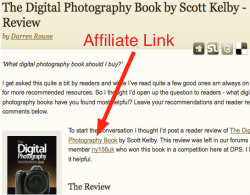 One of the biggest reasons my initial attempts with Amazon fell flat on their face and simply didn’t convert was that I thought it’d be enough to slap an image based button on my sidebar that featured a product or that was simply a banner ad to Amazon.
One of the biggest reasons my initial attempts with Amazon fell flat on their face and simply didn’t convert was that I thought it’d be enough to slap an image based button on my sidebar that featured a product or that was simply a banner ad to Amazon. Amazon give publishers a lot of these type banners but despite trying almost all of them I’ve had little or no success with using them at all. Instead – 99% of my conversions have come from links to Amazon from within blog posts when I’m writing about the products themselves.
By all means experiment with the widgets and buttons Amazon gives you – if they do convert for you then more power to you – but every blogger I’ve talked to that has had success with Amazon tells me that it is contextual links from within blog posts that work best.
11. Promote Specials, Promotions and Discounts
 There’s hardly a product on Amazon that does not have a listed discount on it. Most books are as much as 30% off recommended retail prices and at different times during the year Amazon runs other special discounts and promotions on different single products or in different product categories.
There’s hardly a product on Amazon that does not have a listed discount on it. Most books are as much as 30% off recommended retail prices and at different times during the year Amazon runs other special discounts and promotions on different single products or in different product categories.Keep an eye out for these kinds of promotions because they can be well worthwhile promoting (if relevant to your readership). In fact last time Amazon had cameras on special I promoted it to my newsletter readers and had readers emailing me to thank me for letting them know about it.
Another related tip is that when you’re writing a review of a product and Amazon have a listed discount – include a note about the discount in the post (see yesterdays post about Chris Brogan’s new book for an example).
11 More Amazon Associates Tips Tomorrow
I’ve got another set of tips to share with you on how to make money with the Amazon Associates program tomorrow (update: You can read it here. I’ve also added a 3rd post to the series with 10 more tips for making money with Amazon Associates).I’d love to hear how you’ve gone with promoting this program? Have you had any success? What tips would you give?
Buying and selling online for fun and profit. Learn how to make money from home on eBay and elsewhere with tips, tricks, and how-to's from an active internet marketer.
Get a free MacBook Pro!
As everyone knows that the Blogger is an online service provided by Google to publish the web-pages free of any cost. Blogger blogs are used to provide online journals, Web Portals, Web Gallery and online magazine.etc. These blogs are not only used for these tasks but also to make money online using different programs like
I believe Blogspot is a easy and powerful platform . It can do whatever other platform can do . In WordPress ,with plugins ,you can make a shop online . And now ,in Blogspot ,you can do the same . You can make a small online shop for selling good . It’s not a perfect solution ,in fact, it’s not good at processing and security .But anyway ,it’s still the solution you should consider if you want to stick with Blogspot .
As everyone knows that the Blogger is an online service provided by Google to publish the web-pages free of any cost. Blogger blogs are used to provide online journals, Web Portals, Web Gallery and online magazine.etc. These blogs are not only used for these tasks but also to make money online using different programs like
- Google Adsense
- Chitika
- Kontera
- Commission Junction
- Click Bank
- Affiliates Program
- Private Ads
I believe Blogspot is a easy and powerful platform . It can do whatever other platform can do . In WordPress ,with plugins ,you can make a shop online . And now ,in Blogspot ,you can do the same . You can make a small online shop for selling good . It’s not a perfect solution ,in fact, it’s not good at processing and security .But anyway ,it’s still the solution you should consider if you want to stick with Blogspot .
Quick Tip: Blogging for Customers
Tip for today: You probably have certain keywords that you know people use to find your items for sale. If you have a blog, write a post using those keywords as the topic. Put the keyword or phrase in the title of the post, the first or second sentence of the post, and again in the last sentence of the post. Link the post back to your store. You just might get some traffic - and new customers - that you weren't expecting.Don't have a blog? It's easy to start a free one at blogger.com. Have a blog you've ignored? Resurrect it with a new post, then another, then another. Blogging is a great way to build traffic and find new customers.
How to Start Your Own Online Business
TIME SENSITIVE INFORMATION: Want to learn how to start your own online business? Need someone to answer your questions? I have an answer for you. My friend Phaedra Stockstill is hosting an e-commerce training session for those who are interested in learning how to sell online. Phaedra's an experienced online seller and a knowledgable expert on the subject as well as a dynamic speaker, so I feel quite confident in recommending her training to anyone wanting to build a successful online business.This is an in-person training seminar, to be held November 16, 2010, in Patterson, Louisiana. It is geared toward "newbies," those who have little to no online business experience. Topics include:
- How does it work?
- Choosing a product
- Accepting online payments
- Choosing a venue - eBay, Amazon, Bonanza or your own website
Seating is limited to 10 participants, so you can be assured of plenty of personal attention in this three-hour seminar. The price is $129.99 and I can assure you that this is a small investment for a few hours that could change your life forever. You'll definitely receive your money's worth in valuable information, insider tips, and more.
If you're seriously considering starting your own online business and need good, basic how-to advice from someone who has been there and done that, click here to Learn How to Start Your Own Online Business from a Trusted Industry Expert.
P.S. Not a newbie? Already have an online business? Need to learn to market your business? Check out Phaedra's Internet Marketing Training Seminar.
Where to Find the Best Halloween Costumes to Sell Online
I wanted to share this really great deal with you and the time truly is limited, so please pay attention. If you act before September 10th you can get this outstanding ebook that teaches you exactly where to find and how to sell the best Halloween costumes online for just $20. But you must use the special link provided here. Otherwise, you'll pay the full price of $29.Used Halloween Costumes is a hot market. You can find costumes for under $10 and instantly turn them around on eBay for $30-100 or more RIGHT NOW - if you know what to look for and where to find them! This ebook lays it all out - and even lists over 200 HOT used costumes to look for this year.
The eBook bundle sells for $29 regularly, but through a special arrangement with the author I can offer it to you for just $20 - if you click and buy it right here.
It's not too late to make your $20 back - and much, much more - by following the advice offered in this ebook. Remember, click here for the discount and to get instant access so you can get started right away on finding, listing, and selling the hottest Halloween costumes on eBay or your favorite online selling site.
To read the sales page with all the details about the ebook, go ahead and look HERE. Then when you're ready to buy, come back and click the picture above or click on this special link to claim your discount. Then get busy listing the absolute best Halloween costumes to sell online - and start raking in the profits.
EBay Marketing on Facebook and Twitter
I'm so excited! My friend Beth Cherkowsky of AntiqueDaze has agreed to guest post for us today. Beth has been selling on eBay and at Amazon.com for 13 years and really knows a thing or two about social networking. Today Beth teaches us about marketing our eBay items on Twitter and Facebook. Pay attention; there's a quiz at the end.
So you heard that you should market your eBay items on Facebook and/or Twitter and get more sales? How? I don't mean the "ethics" or advisability of it but HOW? the practical, functional question..how do I get it from there (eBay) over here (Facebook)? Well follow along with me...here is one of my items - see the spot I circled?? That's a handy dandy eBay application that if you click on it, WALA it does almost all the work for you.*
(*follow after the jump)
So you click and you get three options - EMAIL TO A FRIEND, SHARE ON FACEBOOK< SHARE ON TWITTER...
Here's what happens when you pick SHARE ON FACEBOOK
Write a scintillating comment or at least a little "blurb" about this item or at least the category of item (such as "I love Rolypolys but I really like ALL the Harmony Kingdom items' or "this is a vintage rock made in Albania in 1742". Not just "look at my rock".
I'd show you how to share on Twitter but the FailWhale is sitting on everything over there so I can't right now.
Now there are some rules in polite society and there are here too. Ms Manners is busy but here are mine -
I'd show you how to share on Twitter but the FailWhale is sitting on everything over there so I can't right now.
Now there are some rules in polite society and there are here too. Ms Manners is busy but here are mine -
1. I only do one or the other for any particular item - Facebook or Twitter - not both. In part, that is because I had my twitterfeed going to Facebook for a while. But also because the demographics are different so I try to send stuff where I "think" it will be viewed by the folks, who are most likely to "want" it. (someday I'll be smart enough to explain that statement but today is not looking good)
2. Do Not sit there and click on every item in your eBay store which has 5000 items. I will unfriend or unfollow you so fast you won't know what hit you. And so will most other "HUMANS". I didn't follow/friend you to be spammed. But I'll tolerate it occasionally.
3. If I have a category that has say 113 items in it, I sort the MYEBAY page by that store category and then copy that url. I use Tiny URL or BudURL or another "Shortener" (Hootsuite.com has a built-in one) to shorten the link and I'll send a link to the whole category so folks can see for themselves what's interesting. I do not have the patience to tweet 113 things or to put up with anyone else doing that to me either.
4. if you want people to share or retweet your item, keep YOUR tweet or your "blurb" short. Twitter allows 140 characters. If you use 139 HOW do you expect me to retweet it??
So
4A) use "texting" spelling here - GR8 - 4 U - 2 U- C U THERE~
and should be &, tonight can be 2nite or tonite for is 4...and four is 4 SHORT and sweet as my mother used to tell me..
4B) leave me a minimum of 15 spaces to retweet (rt @........) otherwise I'm not gonna do it
4C) In general on Twitter? LOSE THE PUNCTUATION and the obsession with periods. Leave a space at the end of your thought, it's enough.
See you on Twitter or Facebook
@antiquedaze http://www.facebook.com/antiquedaze and http://twitter.com/antiquedaze
@depressionglass http://www.facebook.com/depressionglasswarehouse
Did I tell you that Beth knows her stuff? That's the quiz and the correct answer is a resounding "Yes!" Be sure to follow her on Twitter and "like" her page on Facebook at the links above. Thanks again, Beth, for sharing these great tips with us!





 See you on Twitter or Facebook
See you on Twitter or Facebook